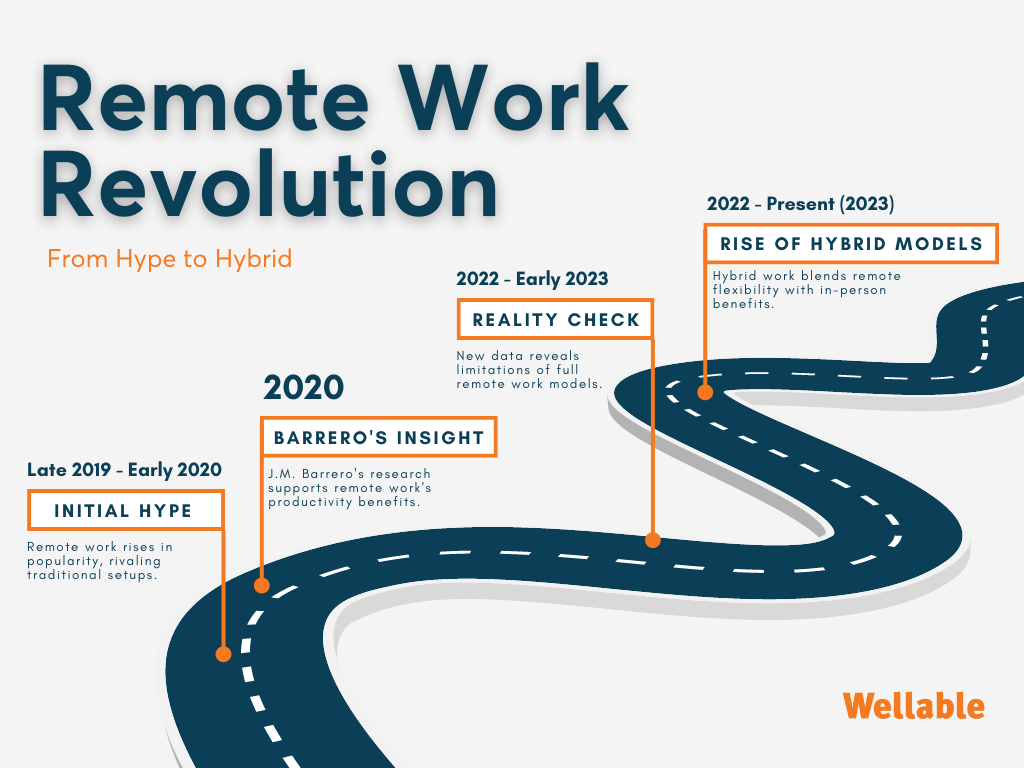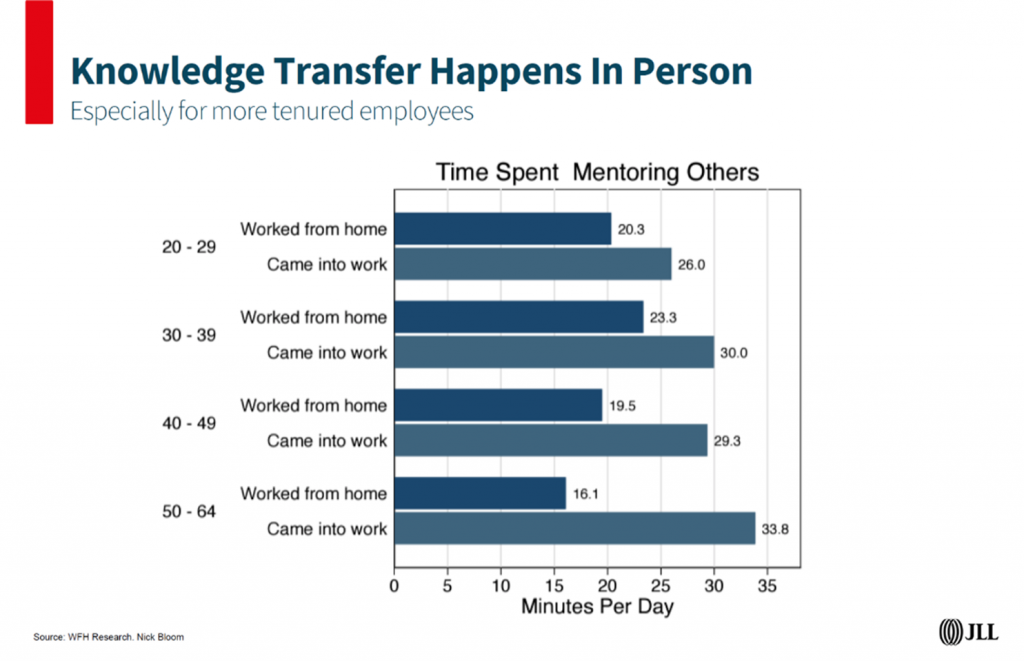In a post-pandemic era, a central theme has emerged – the nature of work has irrevocably shifted. Remote work has become both a solution and a source of controversy, reshaping the traditional office-centered landscape.
While the remote work model offers undeniable benefits, its shortcomings in terms of productivity, communication, and mentorship require a balanced perspective. This article explores the evolution of remote work, exposing its realities and shedding light on a more viable alternative – hybrid arrangements – by drawing on recent research and case studies.
Pressed for time? Here’s a quick summary…
- Shifting Perceptions of Remote Work: Early optimism about remote work’s productivity was later challenged by new research, uncovering a productivity gap influenced by mentorship and communication dynamics.
- Benefits Beyond Productivity: Despite some limitations, remote work offers organizational savings, employee retention advantages, and mental and financial well-being for workers.
- Hybrid: A Balanced Solution: Emerging as a favored model, hybrid work combines remote flexibility with in-person advantages, showing potential for enhanced productivity and job satisfaction.
- The Future Calls for Tailored Approaches: No universal solution exists. Organizations must consider industry dynamics, role demands, and individual preferences to design effective work arrangements.
The Evolution Of Remote Work: Early Evidence & Shifting Dynamics

Initial Hype
At the onset of the pandemic in 2020, the widespread adoption of remote work out of necessity for public health garnered high expectations, suggesting it could rival or even surpass traditional in-office arrangements. Preliminary studies and surveys supported this notion, sparking a revolutionary shift in work expectations for employees and employers.
The Barrero Stamp
Researchers like Jose Maria Barrero amplified this optimism, presenting evidence that fully remote workers matched or exceeded in-office peers in productivity. This boosted companies’ confidence in offering remote work arrangements, buoying employee morale and hinting at a long-term shift toward remote work models.
Three Years On – The Evolution Of Evidence
Fast-forward three years, and the landscape isn’t as clear cut. New research and global industry data have revealed cracks in the acclaimed image of full remote work. While it remained beneficial for some, it couldn’t universally replace the advantages of in-office collaboration, networking, and hands-on mentorship that contribute to a well-rounded work experience.
Hybrid Models Emerge As A Compelling Middle Ground
Amidst the debates and new data, hybrid work models have gained traction. The arrangement offers the best of both worlds, combining remote flexibility with in-person advantages such as mentorship and more efficient communication.

3 Case Studies That Expose Remote Work Realities
The following case studies were derived from a working paper by esteemed researchers, namely Jose Maria Barrero from ITAM Business School, Steven J. Davis from the University of Chicago and the National Bureau of Economic Research (NBER), and Nicholas Bloom from Stanford University’s Department of Economics and NBER. These cases illustrate the productivity gap between in-person and remote work, highlighting the influence of crucial elements like mentorship and communication.

Case Study 1: Remote Software Engineers & Coders
In the field of software engineering, teamwork and constant feedback drive innovation and excellence. This concept is underscored by a study led by Emma Harrington, an assistant professor at the University of Virginia, which examined the impact of physical proximity on collaboration among software engineers and coders.

Key Findings:
- Physical Proximity & Feedback: Coders in the same building had a distinct advantage, receiving 20% more feedback than those on distributed teams. Face-to-face interactions facilitated prompt communication and clarification, enhancing collaboration.
- Drop-In Remote Feedback: With a shift to remote work, the exchange of feedback on code saw a 50% decline compared to the period when the team shared a physical workspace. This decrease raises concerns about potential limitations in work quality and efficiency.
- Impact On Younger Employees: The impact of less feedback and mentorship was particularly pronounced among younger and less experienced employees. These individuals faced a significant reduction in access to guidance, potentially hampering their professional growth.
Case Study 2: Remote Knowledge-Based Workers
The productivity of knowledge-based workers has always been a challenging puzzle for experts, considering the subjective nature of their tasks and the lack of tangible metrics to evaluate their outputs. While remote work offers these professionals the allure of flexibility, it comes with potential drawbacks.
A study conducted by the Harvard Business Review in 2020, in the wake of the COVID-19 pandemic, reveals intriguing insights into both short-term benefits and long-term concerns.

Short-Term Key Findings:
- Lockdown Focus: The sudden shift to remote work during the pandemic led to a 12% reduction in time spent in large meetings and a 9% increase in interactions with customers and external partners, allowing knowledge workers to focus on high-priority tasks.
- Personal Responsibility: Individuals took charge of their schedules, engaging in 50% more activities driven by personal choice, rather than external requests.
- Enhanced Work Value: Lockdown conditions prompted workers to perceive their tasks as more valuable to both employers and themselves. Tasks employees deemed “tiresome” dropped from 27% to 12%, fostering a sense of increased worth in their work.
The transition to remote work during the pandemic was positive for knowledge worker productivity in the short term. However, follow-up interviews with leaders reveal concerns about the long-term effectiveness.
Long-Term Key Findings:
- Communication & Collaboration: Virtual settings hinder spontaneous meetings and collaboration, causing a loss of team “social glue.”
- Mentorship & Development: Virtual environments challenge on-the-job learning and team growth. Online courses have risen but may lack depth.
- Potential Slackening Of Effort: Some concerns arise about the comfort leading to complacency in a prolonged remote work setting.
- Screen Fatigue: Remote knowledge workers often face screen fatigue—a strain caused by prolonged exposure to digital interfaces. This phenomenon can result in diminished productivity and concentration levels.
- Communication Barriers: Remote work can delay communication, hindering the pace of workflow efficiency, collaboration, and decision-making.
- Mentorship Risks: The availability of mentorship remains a concern in fully remote settings, which is particularly impactful for newer or younger employees. The absence of direct guidance and learning opportunities could hinder skill development.
Case Study 3: Remote Call Center Workers & Police Dispatch
Strong evidence related to productivity emerges from fields with clear measurable outputs, as seen in police dispatches, studied by Barrero, and call center workers, explored by Emma Harrington and Natalia Emmanual.

Key Findings:
- In-Person Communication Efficiency: Examining police dispatches revealed that communication efficiency prevailed when both parties, callers who answered 911 calls and dispatchers, were in the same room.
- Pre-Pandemic Productivity: Before the pandemic, remote call center workers lagged in productivity by 12% compared to their on-site counterparts.
- Remote Work Productivity During Pandemic: When all call center employees worked remotely during the pandemic, the productivity gap between remote and in-person workers shrunk. Still, 4% fewer calls were answered per hour.
Addressing The Productivity Paradox
While these case studies highlight the drawbacks of remote work, it’s equally important to consider its benefits. Organizations can save on costs with a fully remote model despite potential productivity dips.
- Office Cost Savings: Embracing remote work can lead to significant savings in office space and related expenses.
- Employee Retention: US employers spend $2.9 million per day looking for replacement workers. According to Barrero’s research, remote workers are less likely to quit their jobs than fully in-office workers. Offering the option for remote work can curb turnover, retain valuable talent, and save money in the long run.

Organizations also gain an expanded talent pool:
- Broader Recruitment Efforts: Remote work opens doors to a wider talent pool by enabling companies to recruit skilled professionals from diverse geographical locations.
Although in-person work provides the benefit of face-to-face interactions, which may improve social well-being, remote setups can boost employees’ mental and financial well-being:
- Mental Well-Being: Remote arrangements can reduce the stress associated with commuting and allow employees to personalize their workspace for comfort, positively impacting their mental health.
- Financial Well-Being: From commuting expenses to work attire costs, and potentially even relocating to expensive urban areas, returning to the office can be a financial burden. Many employees face a recurring cost of over $100 per week for required in-person work. Remote work eliminates these unnecessary expenses, enhancing financial well-being.
The Middle Ground: Hybrid Solutions
While there are inherent benefits of remote work, such as flexibility, certain limitations—especially in areas like feedback and mentorship—are more prominent. On the other hand, traditional in-person settings offer rich interactions but may lack the adaptability today’s employees seek.
The solution? A fusion of both worlds—hybrid work models, which marry the strengths of remote and in-person setups.

Case Study 1: Hybrid Call Center Workers
The effects of hybrid work were examined on 250 call-center employees at cTrip.com, a leading Chinese travel agency. Employees were divided into two groups: one worked from the office full time, while the other worked from home for four days and came to the office for one.
Key Findings:
- Heightened Productivity: Remote employees experienced a 13% increase in daily productivity compared to in-office employees.
- Increased Working Time: Home-based employees exhibited a 9% increase in working time due to shorter breaks and less sick leave.
- Boosted Efficiency: Remote employees displayed 4% greater efficiency per hour.
Case Study 2: Hybrid US PTO Workers
Employees at the US Patent and Trademark Office (PTO) were allowed to work remotely for four days a week, offering greater flexibility while maintaining optimal performance.
Key Findings:
- Increased Work Output: This arrangement yielded a 5% increase in patent actions.
- The Win-Win Of Flexibility: There was a further 8% increase in patent actions when greater location flexibility was introduced, providing employees with more freedom while improving efficiency.
Case Study 3: Hybrid Arrangement At NGO In Bangladesh
At a non-governmental organization in Bangladesh, the human resources department randomized workers into hybrid arrangements, unveiling promising findings regarding productivity and job satisfaction.
Key Findings:
- Greater Efficiency: Hybrid workers demonstrated a notable increase in email activity, with a higher frequency of emails sent and a greater tendency to draft more intricate and comprehensive content.
- Improved Job Satisfaction: Job satisfaction improved among workers in hybrid arrangements.
The Verdict On Hybrid Work

Exclusively remote work is linked to lower average productivity due to communication and professional development challenges. On the other hand, hybrid work shows a neutral to mildly positive impact on performance.
Some organizations may benefit from embracing fully remote employees for cost savings, while many may find hybrid models to be most effective for productivity, talent acquisition, and employee retention.
The Way Forward
So, is a hybrid model the ultimate solution?
The response is more nuanced: not definitively.
While a hybrid model presents a strong initial framework, it’s increasingly evident that there’s no one-size-fits-all approach to work arrangements. Diverse industries, roles, and individual employee preferences underscore the need for customized strategies. What seamlessly suits a software developer might not align as effectively with a sales executive.
Rather than applying a uniform policy, it’s crucial to factor in the distinct demands of various roles, industry dynamics, and, most importantly, the desires and needs of individual employees. Embracing a tailored approach is more likely to yield favorable outcomes in productivity, job satisfaction, and overall company culture.












